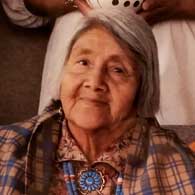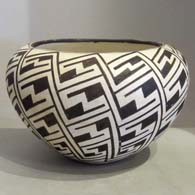Lucy Lewis
1900-1992
Acoma


Lucy M. Lewis was born and raised in Acoma Pueblo on Sky City mesa, a land formation southwest of Albuquerque that rises more than three hundred feet above the surrounding countryside.
As there were no government schools on the mesa and Lucy wasn't escorted by government agents to an off-pueblo Indian Boarding School, Lucy received no formal education beyond that which was traditional to her people, that has long been required of every Pueblo child as they grew up: she helped in the home, she learned the various steps and chants (in her native Keres tongue) necessary to participate in her people's ancient rituals and ceremonies, and she began to make pottery when she was only seven or eight years old. She learned how by watching her great-aunt Helice Vallo and other Acoma Pueblo Corn Clan women as they gathered together and made pottery the traditional way for the kiva and for their personal use.
Lucy was never exposed to off-pueblo pottery influences, her creative inspiration was derived entirely from the sherds she found as she walked around the countryside of Acoma. A large amount of what she found on the ground was decorated with Cibola, Tularosa and Mimbres-style designs. These designs were characterized generally by fine black lines forming geometric patterns, panels of geometric patterns in multiple colors, or black anthropomorphic forms, all on a white slip. From the spark lit by those sherds she developed her own methods of making and decorating pots.
In her teens, Lucy married Toribio Haskaya and together they raised nine children. She handled the household chores, helped her husband with the farming and somehow found time to squeeze in her pottery making. Due to Acoma Pueblo's remote location and the refusal of pueblo leaders to allow archaeologists, ethnographers, collectors, traders or tourists to hang around or do any excavations or business on the mesa top, Lucy was never exposed to (or interfered with by) archaeologists, museum curators, collectors, traders or tourists. She also did not travel to powwows or fairs, though she occasionally sold her pottery at the railroad station in Grants, about 20 miles from Acoma, and along Route 66 (which ran along the north side of Acoma pueblo lands). In spite of this relative isolation, Lucy Lewis is credited with sparking the revival of Mimbres black-on-white designs.
Her pottery first became known outside the pueblo when she exhibited her wares in a juried competition in 1950. She was awarded several blue ribbons that year at the Annual Gallup InterTribal Ceremonial. That brought her to the attention of Dr. Edgar Lee Hewett, Director of the Museum of New Mexico (the same Dr. Hewett who had worked with Maria Martinez years earlier). Hewett convinced her she needed to sign her pieces and as she earned more and more blue ribbons, her signature would become more and more valuable.
Lucy was struck by lightning in 1964. Surviving that gave her great power, and she was often asked to make pottery for use in kiva ceremonies after. It was also around that time that she finally understood that her pottery was worth more than few cents apiece. So she began signing her pieces and charging more for them. For a while, she even added the year when she fired the piece. Then around 1980 she stopped adding the years.
During the 1980s and 1990s Lucy received awards from the American Crafts Council, the College Art Association, the State of New Mexico and the Honolulu Academy of Fine Arts. She continued to make pots until she was well into her 80s. Some of her grandchildren and other descendants are still creating pottery using the methods and decorations she passed on to them.
(505) 986-1234 - www.andreafisherpottery.com - All Rights Reserved
